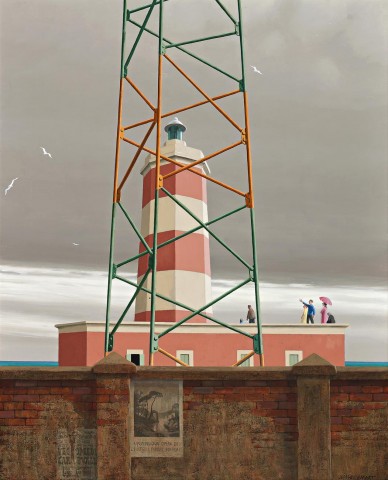THE LIGHTHOUSE, FIUMICINO, 1968 – 69
JEFFREY SMART
oil on canvas
81.0 x 65.0 cm
signed lower right: JEFFREY SMART
inscribed with title verso: THE LIGHTHOUSE / FIUMICINO
bears inscription verso: Prop. I.L.F. MACKAY / MONA / BRAIDWOOD / …
Macquarie Galleries, Sydney
Iain (Jock) Mackay, Braidwood, New South Wales
Christie’s, Sydney, 3 October 1973, lot 485
Alan and Nola Geddes, Sydney
Estate of Nola Geddes, Sydney
Jeffrey Smart, Macquarie Galleries, Sydney, 17 – 29 September 1969, cat. 19 (as ‘The Lighthouse’)
Quartermaine, P., Jeffrey Smart, Gryphon Books, Melbourne, 1983, cat. 513, p. 110 (as ‘The Lighthouse’)
We are grateful to Stephen Rogers, Archivist for the Estate of Jeffrey Smart, for his assistance in cataloguing this work.
Jeffrey Smart’s 1969 solo exhibition at the Macquarie Galleries, Sydney, overflowed with masterly works ranging from End of the Autostrada, 1968 – 69 (private collection), through Approach to the City III, 1968 – 69 (private collection), to our painting, The Lighthouse, Fiumicino, 1968 – 69. Rooftops, 1968 – 69 (National Gallery of Victoria, Melbourne, through the generosity of Dr Joseph Brown) and The Watertower, 1968 (private collection) were among several marked ‘not for sale’. Although The Lighthouse, Fiumicino may not have the same high public profile of its fellows, it is their equal in quality. Moreover, triumphant towers and tall, vertical structures have a particular attraction for Smart. Seen in another Fiumicino subject, Control Tower, 1969 (Art Gallery of South Australia, Adelaide), and two works with even closer relationship to our painting, Alma Mahler Feeding the Birds, 1967 – 68 (Art Gallery of New South Wales, Sydney) and The Watertower, they variously share shaded walls, pink and white banded towers profiled against a clear sky, sea gulls, dwarfed figures and weathered signage. In The Watertower, the Smart scholar, Barry Pearce suggests that the Italian worded sign ‘…forbidding entry to all except authorized workers – maybe a warning against pictorial analysis that only artists were equipped to understand – and a wall of exquisitely nuanced shadow beneath a clear sky straight out of Venetian Renaissance painting, is such a passionate celebration of the miracle of daylight that all aspects of design and detail almost become secondary…’.1 Yet, in The Lighthouse, Fiumicino, the poster, worded ‘UNA NUOVA OPERA DEI FRATELLI FABBRI EDITORI’, tempts trespass into analysis. The news of a new work by the great Italian art publishing house of Fratelli Fabbri Editori is set in an arcadian landscape of curvaceous line, vivid in its contrast with the super-real world of Smart’s imagination in which all is angular and geometric of construction. Rigid lines of straightness rule in emphasis of the rigidity of man-made things – even the horizon and clouds conform with straight lines. Subtly, wheeling seagulls and the poster landscape herald the beauty of the natural world’s flowing line.
The subject is the lighthouse at Fiumicino, near Rome, an octagonal stone tower atop the two-storied keeper’s house. It was once painted in red and white horizontal bands. Doorless, the old shaded brick wall acts as a barricade, keeping the viewer at arm’s length from the sunny side of mouthwatering colour, a sharpness of light and stillness before the storm creating that mood of heightened expectancy of the classic Smart. Other characteristic touches include one only of the four shuttered windows open and, apart from providing scale, the figures’ ambiguous other role. Drama is in the air. From props to lights and actors, the theatricality of it all is enthralling. From nuances of ideas to bold statements, Smart’s tantalising inclination is invariably to leave interpretation to the viewer generously allowing freedom of conclusion. As fellow-artist James Gleeson wrote of Smart’s Sydney exhibition of 1969: ‘He is a narrative painter, who deliberately refrains from telling a story’.2
1. Pearce, B., Jeffrey Smart, The Beagle Press, Sydney, 2005, p. 157
2. Gleeson, J., ‘Still life in two styles’, Sydney Morning Herald, Sydney, 21 September 1969, p. 108
DAVID THOMAS
